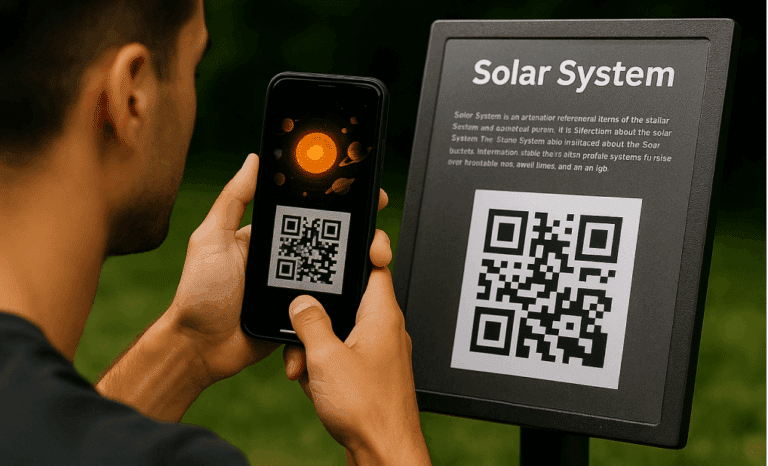In a world where a single scan can launch an immersive 3D experience, QR codes and augmented reality are reshaping how brands connect with their audiences. From product packaging to retail stores, this powerful combination is creating seamless bridges between the physical world and rich digital content — and it’s happening with just a smartphone camera.
Why QR codes and augmented reality are the perfect match
At first glance, QR codes and AR may seem like separate tools. A pixelated square for linking. A layered 3D experience. But together, they unlock something much bigger: the ability to add augmented reality to everyday objects, creating interactive moments that surprise, inform, and engage.
Augmented reality QR codes (or AR QR codes) turn any surface into a potential storytelling platform. Scan a label and watch a product demo pop up in your space. Point your phone at packaging and meet the founder in AR. With the right QR code generator, the only limit is your imagination.
How brands are using AR QR codes today
Across industries, marketers are embracing QR codes and AR to enrich the customer experience and stand out in crowded markets:
Product packaging
A standard QR code becomes a powerful digital layer. Imagine scanning a cereal box and launching an animated farm-to-table journey — or a cosmetics label that lets customers virtually try on lipstick shades in AR before buying. It’s not just flashy; it helps consumers make informed purchasing decisions.
Furniture and home decor
In furniture stores or online, customers often struggle to visualize pieces in their homes. Enter AR code technology: scanning QR codes lets shoppers place true-to-scale 3D models of sofas, tables, or decor into their real-world surroundings using their phone’s camera. It turns static print media into an interactive showroom.

Education and training
In schools or industrial training settings, QR codes linked to AR content can help explain complex processes or bring abstract concepts to life. Think of anatomy models appearing from textbooks, or AR simulations walking new hires through machine operations — all via a quick scan.
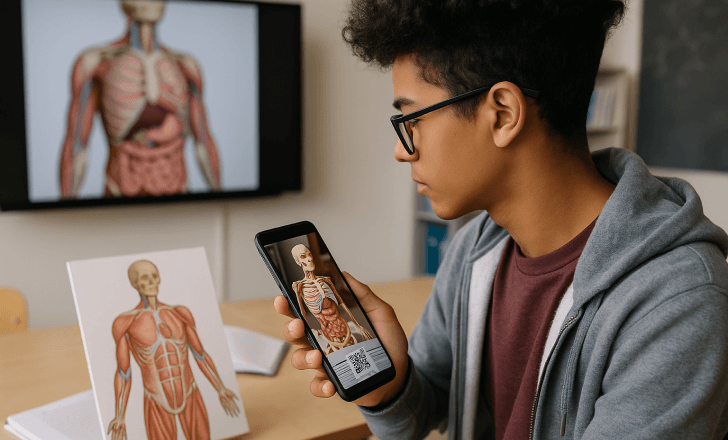
Events and installations
Event marketers now incorporate AR codes into wristbands, posters, or displays to boost engagement. Attendees might scan a wall and be greeted by a virtual tour guide or unlock a secret giveaway with AR. These memorable experiences bridge the physical environment with digital possibilities.
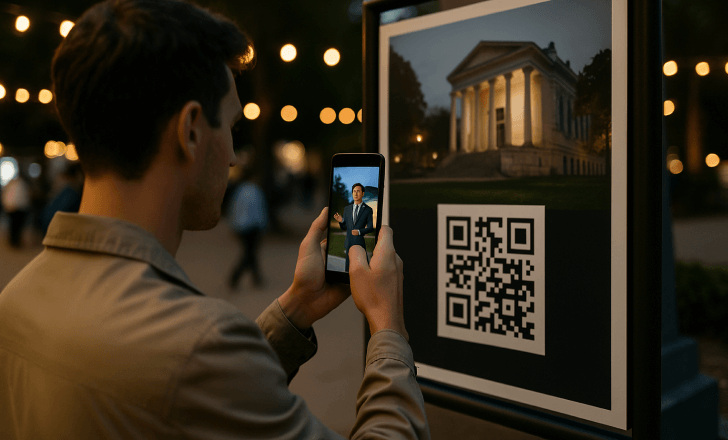
What makes AR codes so effective?
The magic lies in how intuitive it feels. No app download. No long instructions. Just a quick scan with a smartphone camera and the digital content launches.
This creates a frictionless gateway to high-impact digital experiences — the kind that enhance user engagement, encourage longer dwell times, and boost brand loyalty.
And because dynamic QR codes can be updated after printing, you can change the experience without needing new materials. That’s huge for marketing campaigns and product packaging in fast-moving industries.
The impact on e-commerce and in-store experience
QR codes and augmented reality are bridging the gap between online shopping and brick and mortar stores.
- In-store: Shoppers can scan shelf displays or product tags to watch AR product demos, compare specs, or see accessories in 3D.
- Online: Brands can print AR QR codes on mailers or catalogs, allowing customers to interact with products at home before visiting a store or placing an order.
This hybrid approach amplifies customer engagement and creates a consistent brand experience across touchpoints.
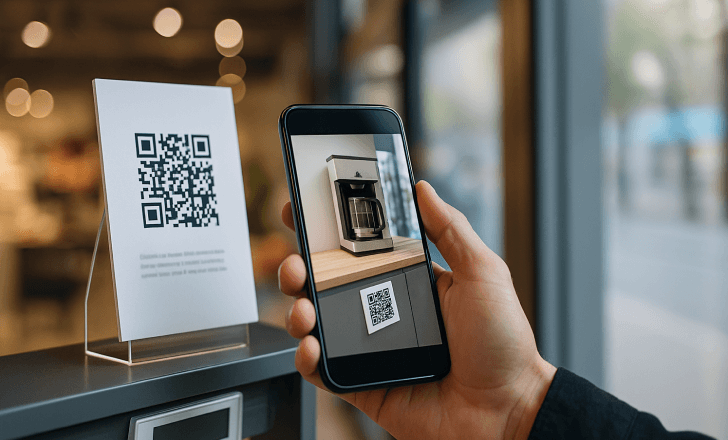
Creating AR content with QR codes: What you need to know
Adding augmented reality to your QR code campaign isn’t as complex — or expensive — as it used to be. Thanks to more intuitive platforms and no-code tools, creating immersive AR QR code experiences is within reach for marketing teams, agencies, and even small businesses.
Here’s a step-by-step look at how to build your first AR QR campaign:
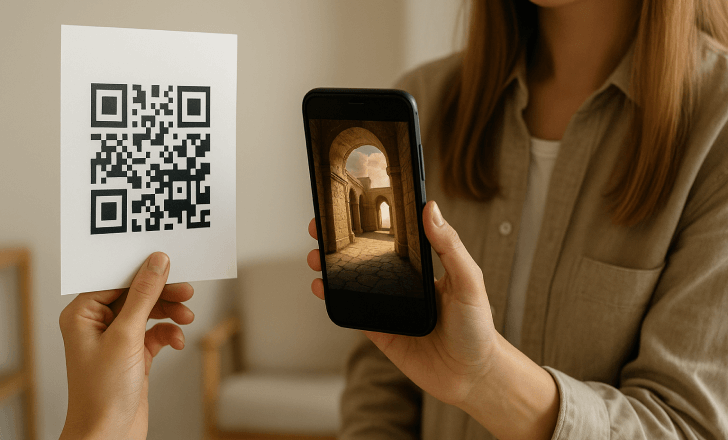
1. Create the augmented reality experience
This is the foundation of your campaign. The AR content can take many forms, depending on your goals:
- A 3D model of a product placed in the user’s real environment (perfect for furniture stores and product demos)
- An interactive animation layered over a printed item, such as a product label or brochure
- A guided video, virtual avatar, or explainer that appears in the user’s physical surroundings
- An AR portal that invites users to “step inside” a digital world, such as a showroom or educational experience
Many AR platforms now include drag-and-drop tools that allow non-developers to build these experiences quickly. Some even offer templates tailored to common use cases in retail, e-commerce, events, and packaging.
2. Host the AR content online
Once your AR experience is created, it needs to be hosted on a mobile-optimized web application. This is what the QR code will link to — so performance matters.
Choose a platform or CMS that:
- Loads quickly on mobile networks
- Supports WebAR (augmented reality experiences delivered through the browser, with no app download)
- Offers analytics, so you can track how users interact with your content
Hosting the AR content on your own domain can also boost SEO and help build trust during the user experience.
3. Generate the dynamic QR code
Now it’s time to connect your AR content to the real world.
Use a dynamic QR code generator — like QR Code KIT — to create a scannable code that links to your hosted AR experience. Dynamic codes offer flexibility: if you want to update the experience later (for example, swap the 3D model, add new content, or run a seasonal version), you can do so without reprinting your QR materials.
At this stage, you can customize the QR code to match your brand colors, add a logo, and apply design best practices to boost scan rates.
4. Test across real-world environments and devices
Before going live, test the full AR experience:
- Does it launch instantly when scanning the QR code with a smartphone camera?
- Is the AR content stable and well-anchored in real-world surroundings?
- Does the experience display correctly across different phone models and screen sizes?
- Is there clear lighting and surface detection in indoor and outdoor settings?
Test your AR QR code in the exact context where users will encounter it — whether it’s product packaging, print media, signage, or in-store displays. Real-world testing ensures that your interactive AR content works smoothly and feels intuitive, delivering a fun experience instead of a frustrating one.
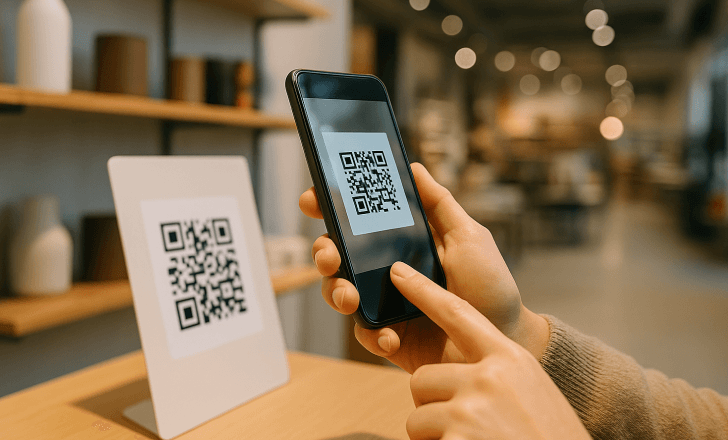
Advanced analytics: Measuring success beyond the scan
One of the lesser-known advantages of combining QR codes and AR is the access to detailed analytics. Dynamic QR platforms like QR Code KIT allow marketers to track:
- Number of scans
- Location and time data
- Device type
- Engagement duration with the AR content
This data helps fine-tune future campaigns and understand which digital elements drive the strongest responses from your target audience.

Where this trend is headed next
As AR technology becomes more accessible and consumers grow more comfortable with interactive content, expect to see:
- AR codes on more everyday items: from coffee cups to shopping bags
- More immersive experiences: layered sound, gamified interactions, real-time customization
- Better integration with social platforms and mobile browsers
- Increased use in sustainability communication: such as showing carbon footprints or recycling tutorials through a simple scan
In short, the line between the physical and digital worlds is dissolving. And QR codes are leading the charge.
What industries benefit most from combining QR codes and AR?
Retail, consumer packaged goods (CPG), education, healthcare, travel, and entertainment are among the first sectors to embrace the combination of QR codes and augmented reality — and for good reason. In retail and e-commerce, AR QR codes offer immersive experiences like virtual try-ons, 3D product previews, and interactive promotions that boost customer engagement. In education, they bring static textbooks to life with AR content that explains complex concepts visually. Healthcare organizations use AR codes to deliver real-time instructions, post-op care guides, or even 3D models of medical devices.
Travel and hospitality brands are also exploring AR QR codes to provide virtual tours, destination previews, and interactive hotel services. Even traditional industries like manufacturing and logistics are beginning to adopt AR QR code technology for employee training, equipment maintenance, and safety information. In reality, any industry looking to merge the physical and digital worlds to improve communication, customer experience, or product understanding can benefit.
Can I add augmented reality to an existing QR code?
Yes — as long as you’re using a dynamic QR code, you can absolutely add or update augmented reality experiences without changing the code itself. Dynamic QR codes are designed to be flexible: they allow you to change the destination URL or the underlying experience at any time, even after printing the QR code on packaging, signage, or promotional materials.
For example, a company that launches a seasonal product line can update its AR content to reflect the latest campaign while keeping the same printed AR QR code. This flexibility not only saves costs but also futureproofs your marketing strategy. It ensures that your AR content stays relevant and aligned with evolving campaigns, customer needs, or product information — all without needing to reprint or redistribute materials.
How do I ensure a good user experience when using AR QR codes?
Creating a smooth and enjoyable AR QR code experience starts with the basics: make sure the content loads quickly, works well on all major mobile devices, and doesn’t require users to download a separate app. Web-based AR is ideal because it lowers the barrier to entry — users just scan and view.
Design your AR experiences to be short, engaging, and intuitive. Think of them as interactive moments, not full-length videos or complex games. A good augmented reality QR experience should launch in seconds and guide users with on-screen prompts or a clear interface. Also, always include a call-to-action (CTA) near the QR code that tells users what they’ll get from scanning — such as “View in your space,” “Watch in AR,” or “See it in 3D.”
Finally, test your AR content in real environments to ensure stability, lighting compatibility, and surface detection. A well-executed AR experience doesn’t just impress — it builds trust and encourages repeat interactions.

Are QR codes and AR suitable for small businesses?
Absolutely. You don’t need a massive budget or a full development team to start using QR codes and augmented reality in your business. Many AR platforms today are built for ease of use, offering templates and drag-and-drop builders tailored for marketing teams, creatives, and small business owners. Combined with a reliable QR code generator, even solo entrepreneurs can launch interactive campaigns in just a few steps.
Small businesses in particular can use AR QR codes to stand out: a coffee shop might let customers scan a cup to see how beans are sourced, while a boutique could offer AR fitting rooms to boost online shopping confidence. Adding augmented reality helps these brands create memorable experiences that blend physical and digital touchpoints — and build deeper customer connections in the process.
